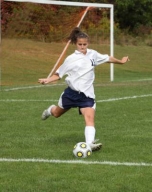Young Women Beware of an ACL Tear
Medically Reviewed by Patrick K. Denton, MD
A pop! The sound of cracking! A feeling of glass breaking! Descriptions may differ. But each represents the tearing of the anterior cruciate ligament (ACL) of the knee joint – a problem that is 8 times more likely to affect teenage females than males.
What is an ACL Tear? The ACL is one of four ligaments that stabilize the knee. It’s a rubber band-like fiber about the size of your little finger that runs through the knee joint, attaching the thigh to the shin.
When an ACL separates, it’s less a tear than a shredding of the ligament. Surgeons can’t simply reattach it. Replacement is required.
“In ACL tear surgery, we usually replace the ligament with other tissue from the patient,” says Orthopedic Surgeon Dr. Pat Denton of McLeod Orthopaedics. “After repair and a 6-9 month rehabilitation, the new ACL is as strong as the original.”
Why Women More than Men?
“An epidemic” is the way one athletic trainer describes the ACL incidence in females versus males. Since 1972, when Title IX expanded sports opportunities in women’s athletics, the number of athletic injuries in females has increased dramatically. No surprise there. However, young women suffer ACL injuries 2-8 times more often than boys participating in the same sports. The most common sport for girls’ injuries is high school soccer, followed by basketball, then softball.
Contact has little to do with the injury. Some 70-80% of the ACL tears occur without impact from another player. It’s more like to happen on landing from a jump, quickly changing direction or suddenly slowing.
Hormones. Since women 15-19 years of age are most likely to be injured, some of the cause has been tracked to puberty. Increased levels of the hormone testosterone build muscle in males. Females get less testosterone and, in turn, less muscle mass.
Females are also more likely to suffer an ACL tear near the beginning of a monthly period. One study even found that oral contraception had little protective effect on this tendency.
Body Structure. Women tend to be more “knock kneed” than men – their knees pointing inward when they run and jump. Women’s knee joints are more flexible than males. Females tend to rely on bones and ligaments to stop, rather than using muscles as men do. Females also tend to have less core strength and stability, limiting their ability to prevent their mass from shifting away from support. Neuromuscular training in female athletes has demonstrated a protective effect on the ACL.
ACL Tear Symptoms
After the characteristic sound, the leg buckling and pain – there is often swelling for 3 or 4 weeks. When the swelling goes down, the person may not experience discomfort during daily activities. However, any return to sports will cause the knee to buckle and lead to more damage.
Preventing ACL Injuries
Specialists use a number of programs to help young females prevent the ACL injury. One such program, Sportsmetrics, is offered by McLeod Sports Medicine. For more information, click here.
To find a physician, click here.
Sources include: McLeod Health, National Institutes of Health, American Academy of Orthopaedic Surgeons, American Orthopaedic Society for Sports Medicine, Orthopaedics & Traumatology, journal of Athletic Training, NJ.com, Contemporary Pediatrics
-
McLEOD REGIONAL MEDICAL CENTER FLORENCE
843-777-2000 -
McLEOD DARLINGTON
843-777-1100 -
McLEOD DILLON
843-774-4111 -
McLEOD LORIS
843-716-7000 -
McLEOD SEACOAST
843-390-8100 -
McLEOD CHERAW
843-537-7881 -
McLEOD CLARENDON
803-433-3000



-
McLEOD REGIONAL MEDICAL CENTER FLORENCE
843-777-2000 -
McLEOD DARLINGTON
843-777-1100 -
McLEOD DILLON
843-774-4111 -
McLEOD LORIS
843-716-7000 -
McLEOD SEACOAST
843-390-8100 -
McLEOD CHERAW
843-537-7881 -
McLEOD CLARENDON
803-433-3000
 Find a Doctor
Find a Doctor  Locations
Locations  Services
Services 